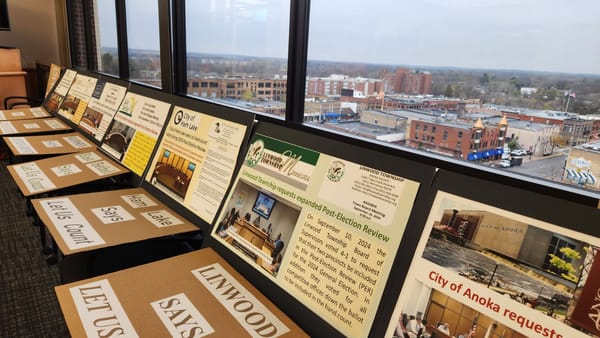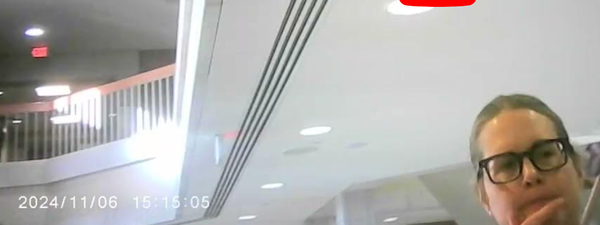Dakota County Distress Continues
DC data only 1.1% complete one day after certification; 19 counties below 1%; Statewide data 49.5% incomplete
On November 29, 2020, 25 days after the Nov 3 general election and 5 days after the MN State Canvassing Board certified that election, out of about 1.9 million absentee records there were still 734,000 absentee records NOT aligning with the statewide voter registration system (SVRS), in other words, not connected to a voter.
For the 2022 midterms, the number as of Nov 23, 2022 (two weeks post election), is 317,372 of 657,575 (48.3%).
Is it acceptable that this work—one click of a button—isn't being done and equally acceptable that our current state statutes allow it to be left undone while both county and state elections get certified?
It is a mystery how every Minnesota county was able to certify the Nov 8, 2022 midterm election on either November 21 or November 22 without informed consent through transparent disclosure of this public election data. It is also a mystery (although less and less of one) what is happening behind the scenes in the realm of the statewide voter registration system while counties delay submitting their data.
One piece of good news: Instead of waiting for state law to be changed, going forward county commissioners could pass resolutions to require 100% of the data to be complete prior to county-level certifications. The resolution could read: The county auditor shall have all voter histories prior to certification.
But that forward-looking change does not change the facts on the ground right now. This writer is reminded of Martin Geddes’ reformulation of Arnold Beisser’s paradox of change: “…to get to a better world, we have to fully immerse ourselves in the awfulness of the present one.”
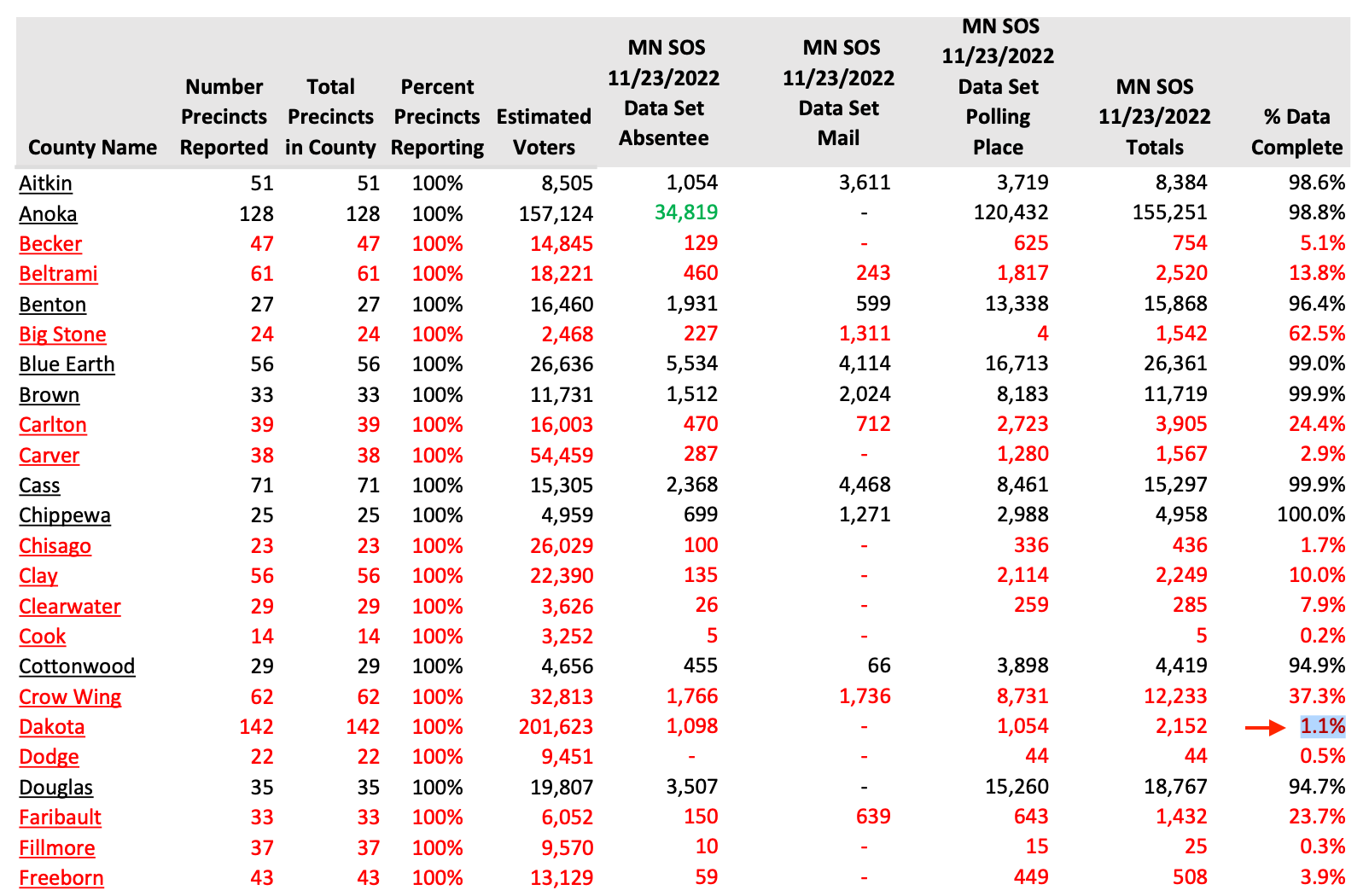
The following PDF file contains the full list of county-level data:

Mn 2022 Gen Electionsvotingmethod20221123data244KB ∙ PDF fileDownloadDownload
Dakota’s Recent Election History
In the data illustrated and linked (PDF) above, many of Minnesota’s 87 counties had incomplete data after their county level certifications, which raises the obvious question: How were the members of the county canvassing boards able to certify their county elections with this gap in information? Or put more frankly: Do these certifications tangibly mean anything at all?
If counties are rubber stamping unofficial election results without complete data oversight and any chance for inquiry, then what is to stop the MN State Canvassing Board from doing the same tomorrow, November 29, for the state level elections?
“The county commissioners, at the end of the day, it’s their name on the county elections.”
—Erik van Mechelen, speaking in Olmsted County on June 6, 2022
By Nov 23, some of the larger counties had apparently completed much of their work. Remember, it is only a click of the button to transfer absentee data and another single click in the pollpad module—then the statewide voter registration system (SVRS) is updated. For instance, Hennepin County, 7 days after certification on Nov 16, had completed 94.8%. (However that remaining 5.2% of data represents 28,957 voters.)
While many counties can and should be investigated by their inhabitants (19 counties had produced less than 1% of their data as of November 23), today’s deep dive will be into Dakota County since I was present at a number of meetings throughout 2022 leading up to this well-below-average performance.
154,000 Absentee Ballots Not Connected in 2020
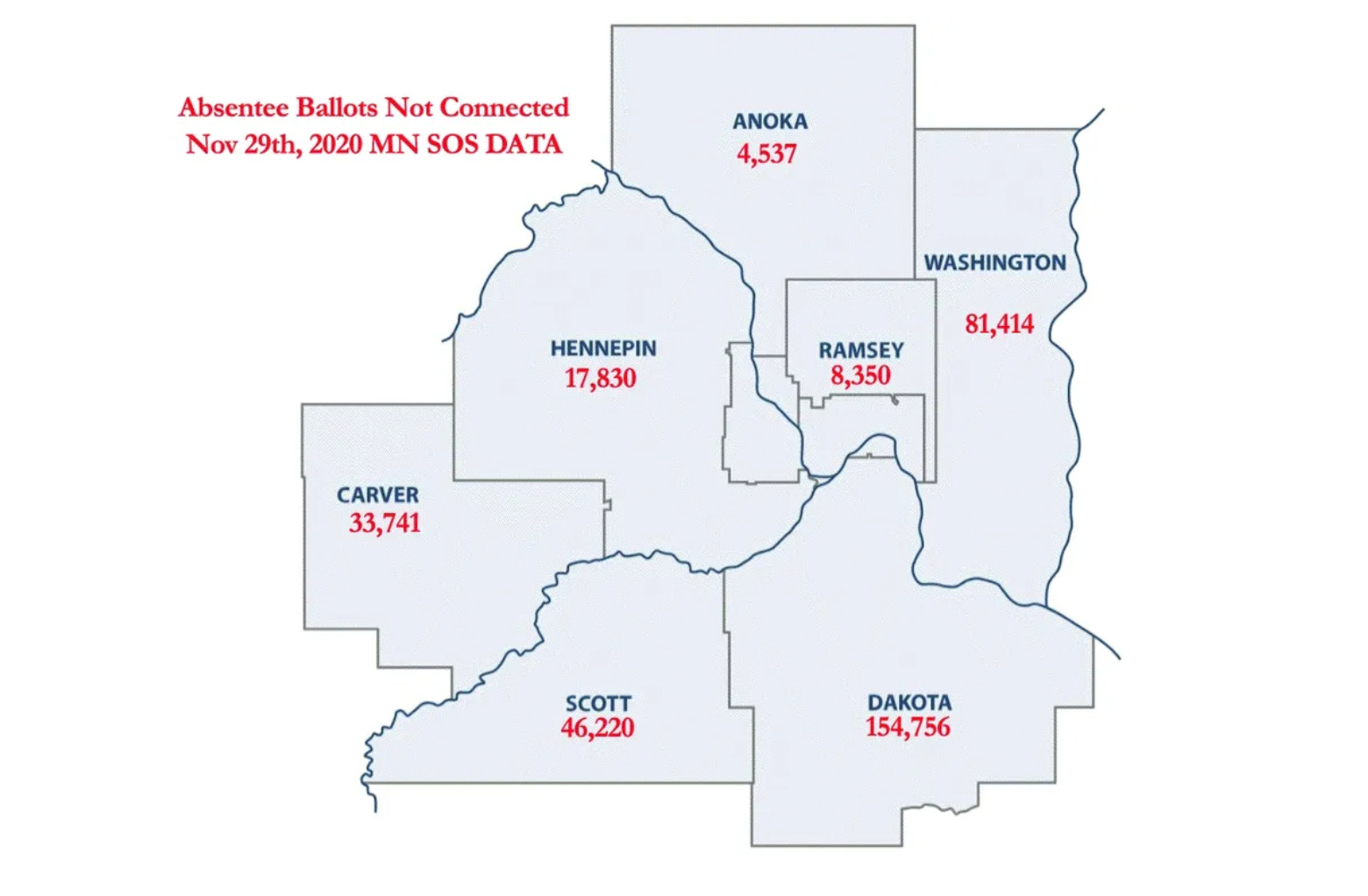
Dakota County was the biggest offender (by volume of records) in 2020’s state-level lack of clarity surrounding absentee ballots. The counties and Minnesota Secretary of State had still not had to answer to significant reporting delays and in some cases missed deadlines.
Remember, this public data was and is provided directly from the Minnesota Office of the Secretary of State, in some cases by request. Want to inqure further? Consider starting a conversation with the MNSOS.
Any Minnesotan can find election administration information and request voter data.
The 2021 School Board Election in ISD196
My first visit to the Dakota County Government Center was in April of 2022. After two more county commissioner meetings, I was invited to another, slightly more interesting meeting.
2021 school board candidate Kim Bauer helped me find the closed door meeting down the hall from the government center foyer. Inside were two election staff, their supervisor, and one commissioner, along with three others (besides myself) there to sort out discrepancies between the statewide voter registration data and the data provided by school district 196 and Dakota County for the 2021 school board election. This was about half a year after that 2021 school board election.
During the meeting the elections manager wasn’t able to reconcile the data. Perhaps sensing the tension his supervisor tried to hurry us along to a mutually accepted conclusion. Even while it was clear the data didn’t add up, I remember him saying something like, “Well are we good then?” It was a bit desperate.
Thankfully Rick Weible said that he wasn’t satisfied. The meeting ended with the county staff making more assurances which I’m not sure have to this day been met satisfactorily. On the day I was left with more questions than I’d come in with (which is a welcome result for those seeking truth and accountability).
The school board election from 2021 was not the only issue the residents of Dakota County had related to elections. The overall election transparency conversation would continue in a subsequent General Government & Policy committee meeting on June 7, 2022, where the election process and electronic voting systems were on the agenda.
How Hard is it to “Click the Button”?
There, the elections manager said his team does not immediately “click the button” to send absentee data to the official statewide voter registration system because he wants to ensure all the data is accurate first (even though state statute gives 6 weeks for this to occur, some counties missed the deadline in 2020).
But when the elections manager was asked if during their 6-week period they had ever found anything significant, he said No. Then why not click the button so that county canvassing boards may access the data and so that the public can as well? (There are a reasonable number of well-equipped Minnesota residents capable of spotting errors to help the OSS clean up the SVRS and local county discrepancies in the voter rolls, registrations, and histories.)
And yet, despite these in-person conversations in 2021 and 2022 and further discussions by email, Dakota County failed yet again to complete their work in a satisfactory manner for the 2022 midterms coming on top of previous questions like this accepted absentee data pattern.
Dominion Software End of Life
The transfer of absentee data wasn’t the only discussion item on June 7—a day when it was decided to move the meeting to a smaller conference room leaving dozens of people to watch remotely from the larger commissioner board room—the elections staff were also responding to the county being notified on April 6, 2022 during a county commissioner meeting that their election software was end-of-life.
In software terms, end-of-life means either out of date or unsupported by the manufacturer. We have learned from people like Col. Shawn Smith, speaking in the Oct 26, 2022 Pennington County, SD commissioner meeting (donning a “The Constitution Matters” hat) that certifications and testing protocols do not defend against cyber threats… and end-of-life software does not improve Dakota County’s distressful situation.
In the meeting, the elections manager attempted to brighten confidence but his explanation is puzzling at best.
“Unfortunately the lag and the way that Minnesota is so unique creates a delay in getting software here.”
—Andy Lokken, Elections Manager Dakota County in a GPP meeting on June 7, 2022
Further reading and viewing:
David Clements, “slave”, speaks in today’s Maricopa County Board of Supervisors Special Meeting - it’s possible we have a system level issue involving ballot print requests being routed to a ballot printing system and on to printers at vote convenience centers
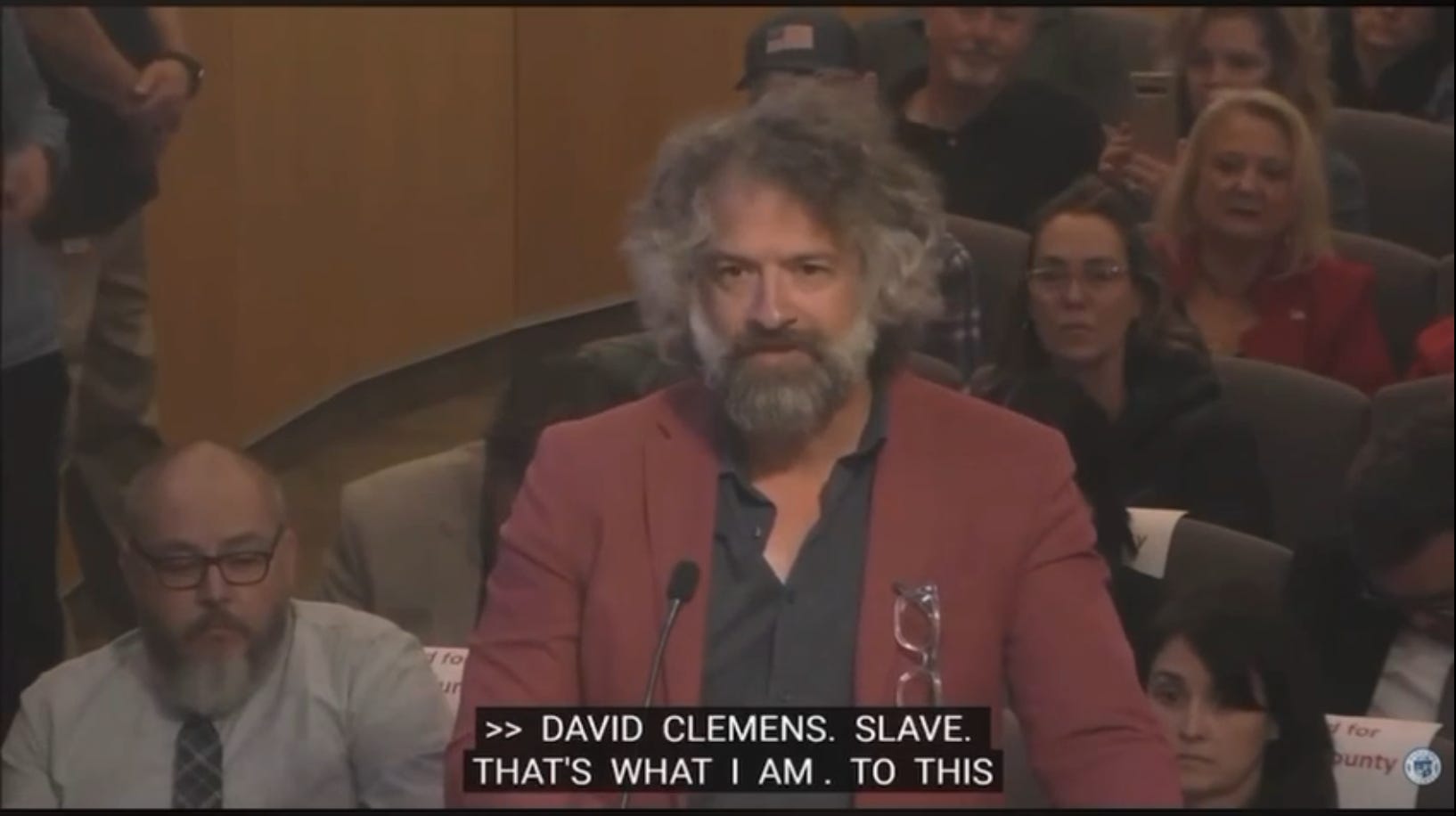
[S]elections in Minnesota (read free) - short book published June 26, 2022 (print copies also available for purchase online from major bookstores)
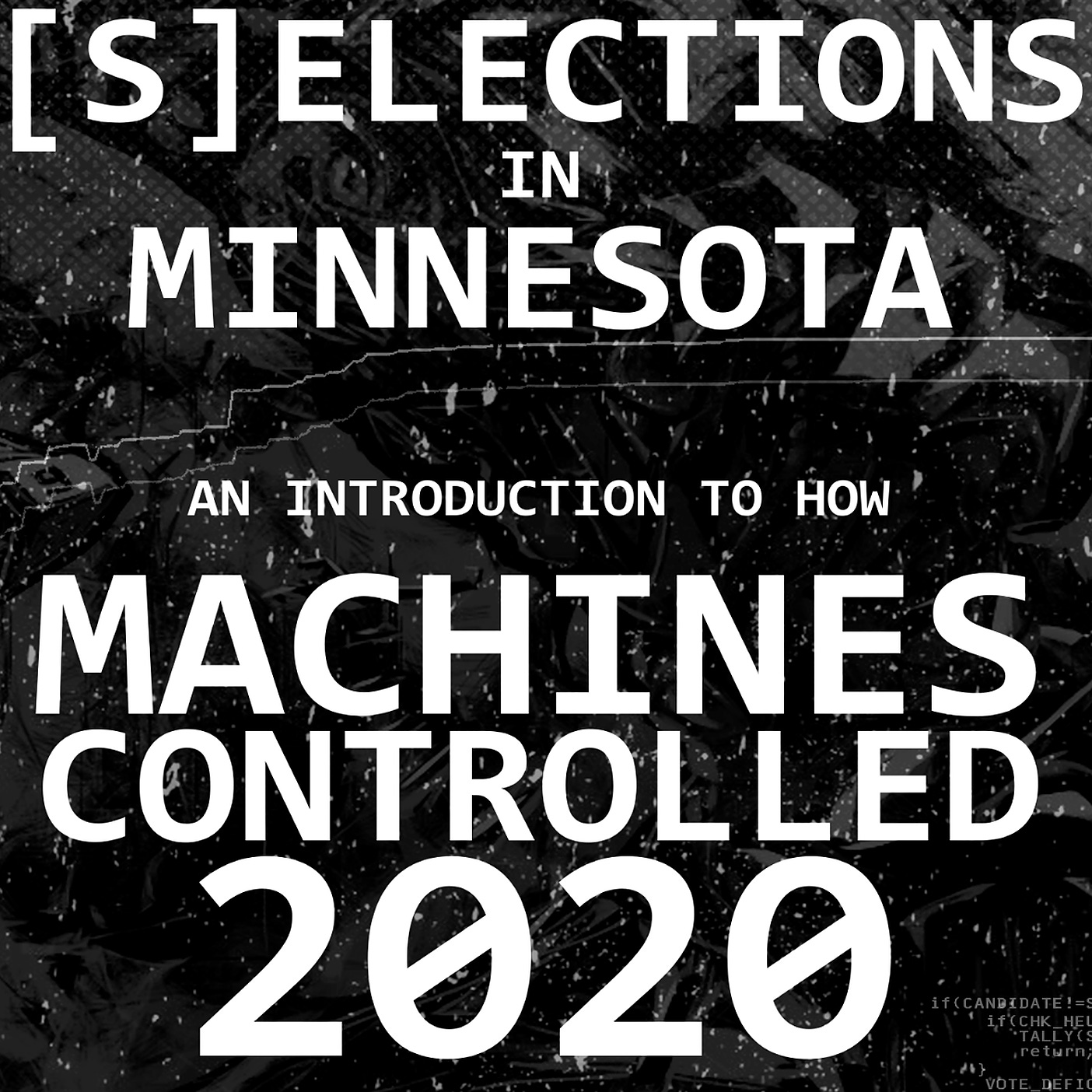
For more about the electronic voting system, I recommend this publication, the Election Data Analyzer (also on Substack). Here’s their latest post:
For more about Konnech Inc. (currently under contract by Minnesapolis) and True the Vote saga, try Kanekoa’s newsletter:
For worldwide highlights like Brazil, Ukraine, China, FTX, energy, finance, bio, tech, Twitter, and American elections try War On You on Telegram ← will save you time! or this newsletter from Martin Geddes (from the UK) providing observation and synthesis on the road ahead… his latest:
Upcoming events
A few minutes speaking about Minnesota in the Springfield Moment of Truth Summit in August of 2022 only offered a short window to share highlights of progress toward accountability in this state. Therefore in coming months will be doing very limited speaking events focused on education of electronic voting systems, election process, and election law to give Minnesotans the tools to engage their county staff on important conversations of election transparency and accountability.
May do some before then, but my next scheduled event will be on Jan 8, 2023 where my first ever speaking event took place hosted by Diana Friemann despite suggestions from members of one major political party that she disinvite me (hint, not the DFL!). I look forward to joining the SE MN Patriots again. A lot has happened since and there’s much to do.
Jan 8, 2023: SE MN Patriots at the Eagles Club in Rochester, MN
90-minute presentation + extended Q & A
Please contact erikvanmechelen@protonmail.com with any questions.




